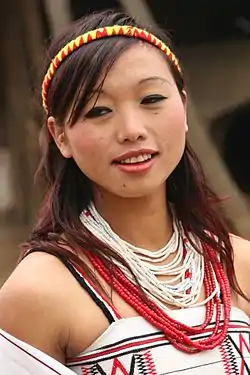Thangal Naga
The Thangals are one of the indigenous Naga[1] tribes restricted to the Senapati district of the state of Manipur in north-east India. Presently there are 13 Thangal villages. They are found in eleven hill villages of the Senapati District. Mapao Thangal, Thangal Surung, Makeng Thangal, Tumnoupokpi, Tagaramphung (Yaikongpao), Ningthoupham and Mayakhang are some of the bigger villages.
They speak the Thangal language, which resembles Maram, and Rongmei.[2] They are Mongoloid in appearance. They are close-knit and live in hill villages mostly located along the National Highway No. 2. Traditionally Thangals are farmers cultivating a range of crops such as rice and pulses; vegetables such as brinjal, potatoes, tomatoes, chillies, cucumber and mustard leaf; fruits such as mango, papaya, plantain, pomegranate; and fruits locally known as tii. The agricultural implements that these Thangal tribes use to a great extent are the adze, sickle, axe, plough, and yoke.
Some villages practice jhum, or slash and burn agriculture. Animal husbandry and poultry farming are also the occupations which make them self-sufficient. Women are engaged in various cottage industries, especially weaving.
Ethnic dress
The traditional attire of the Thangal tribe reflects the inherent simplistic lifestyle of the Thangal people. The people of the region, both men and women, generally dress in bright and colorful attire. The principal dress is largely traditional in nature.
The way the Thangal people wear clothes is unique from other communities. During social functions, the females wear clothes like the Thangal mekhela called pa-thoi, a wrap and shawl. The mekhela is the main ethnic dress of Thangal women, worn by women of all ages. It is in the form of a wide cylinder of cloth folded into pleats draped from the waist downwards. The folds are to the right, as opposed to the pleats of the saree, which are folded to the left. (thus the Thengal dress is akin and similar to mekhela worn by women of various indigenous Assamese ethnic groups). Strings are never used to hold the mekhela around the waist. Ornamental designs on the mekhela are traditionally woven, never printed. This garment plays a symbolic role in the social architecture of the Thangal woman. It is worn during social celebrations, official meetings and the observance of National Day.
Men prefer to wear trousers and shawls, which are generally hand woven. A piece of cloth called a muffler is worn around the chest.
It is unfortunate that the Thangal traditional attires are endangered due to dearth of research and documentation which prevents inter-generational transmission. Moreover, the impact of American Christian missionaries undermined the growth of rich cultural heritage.
Society
There are seventeen ancestral lineages of Thangal tribes. Kadei Keimei, Payei Naomei, Syong Duimi, Payot Naomei and Deibung Naomi, Maguipuinamei are some of the well-known clans.
The selection of mates is restricted by the "rules of lineage exogamy", i.e., the brides should be from other lineage groups. The Thangal society is a monogamous one following the tradition of a nuclear family.
They celebrate the Maamalang festival after the monsoon, after transplantation of paddy.
Thangal Surung dance is one of the popular cultural aspects of Manipur.
Many of the festivals commemorate various socio-religious rituals and customs related to farming. Some of the festivals are fixed as per the position of the full moon (Hadet). In the month of May or Kaphala, the first Thangal month, the two-day festival of Kapha is held. They worship Keirong-raiba for good health and prosperous society. In Jangheiha month (May–June), festivals of Imphoi Dangnit are held. Special prayers are held to save the seed-grain from pests. Janghei is a two-day festival feted to beat back evil spirits, namely saraikagai. Other festivals include the seed sowing festival called Linhut tangnit. A dance festival, Kakhoi Yagathou, is observed. This involves praying the deity for prosperity and growth of village.
13 August is celebrated as Thangal Day. This is to commemorate the martyrdom of Lungthoubu Thangal,[3] better known as Thangal Menjor, or popularly as Thangal general in the year 1891.
Contemporary Thangals are employed in the government and private sectors. The literacy rate is nearly 50 percent. They practice and profess Protestant Christianity.
Village administration
The legislative, executive and judiciary functions of the Thangal tribe are fully vested on village authority. A hereditary office of Khullakpa leads it. The council also consists of Khullakpa (chief) and other elected members. After the Manipur village Authority (Hill areas) Act, 1956 the modification in the structure occurs as:
- Chairman is always the Khullakpa
- Secretary is the Luplakpa
- Treasurer
- Members
References
- Hodson, TC. Naga tribes of Manipur.
- "Thangal language". Ethnologue.
- "Thangal General descendant of the hills". Manipur Online.
